Night-Time Noise Index Based on the Integration of Awakening Potential
Abstract
:1. Introduction
1.1. Noise-Induced Sleep Disturbance and Indices of Night-Time Noise
1.2. Neurophysiology of Sleep and Awakening
- The brainstem integrates awakening potential, but not the sound energy of the external stimuli.
- The brainstem integrates the potential with a first-order lag system and a time constant of approximately 10–100 s.
- The threshold levels of awakening due to short-duration noises are extremely high, while the and SEL both overestimated this parameter.
- The SEL index overestimates even for long-duration noises because the brainstem integrates the awakening potential with a time constant of 10–100 s.
2. Method
2.1. Introduction of
- Passchier-Vermeer [15] reported a dose-response relationship between the probability of behavioral awakening and the SEL of a single noise event, expressed as Equation (8). This relationship is considered to be important, because it was based on field studies including a recent field study [9,10], where motility and self-reported sleep disturbance were also measured, and the number of noise events was considered to be represented in the when motility is used for evaluating sleep disturbance. In addition, this Passchier-Vermeer relationship was used to establish the “Night Noise Guideline for Europe” by the WHO Regional Office for Europe [4].
- The ANSI [18] defined a dose-response relationship between the probability of behavioral awakening and SEL, expressed as Equation (9). This relationship, which was authorized for use by the ANSI, considered the effect of the elapsed time after falling asleep, and therefore, the probability of awakening was calculated to be higher than that calculated using Passchier-Vermeer’s equation.
- Basner [8] reported a dose-response relationship between the probability of EEG awakening and , expressed as Equation (10). This relationship was based on a field study using polysomnography, and therefore, the result was fundamentally different from the other field studies. EEG awakening was defined using polysomnography, which was expected to occur spontaneously 8760 times per year. The effects of the elapsed time after falling asleep, sleep stages and REM sleep were accounted for in the relationship.
2.2. Redefinition of the Index
2.3. Application: Community Noise in a Suburb
2.4. Application: Effect of a Noise Barrier along a Motorway
- Instruments: high-precision sound level meter, NL-31, RION (A-weighted, fast, 0.1-s interval sampling) and digital recorder, R-09, Roland , with a binaural microphone, BME-200, ADPHOX (pulse-code modulation (PCM) recording).
- Date: 1:00–4:00 a.m. 28 November 2007 (before), 1:00–4:00 a.m. 29 February 2008 (after).
- Procedure: Successive 20-min noise measurement and audio recording were performed at each point, respectively. We determined a dominant sound source every moment [32], and night-time noise indices were calculated with the available data where the dominant sound source was road traffic noise.
3. Results
3.1. Overview of
- Each approximated curve has an inflexion point at the high sound level since the duration of a single noise event calculated using Equation (16) is short when the maximum sound level is high.
- The probability of awakening calculated using Equation (13) is discontinuous at the threshold of 39 (dB), since a logistic function was selected to understand the probability of awakening in the ANSI method.
- The probability of awakening calculated using Equation (10) rises steeply to the threshold, since this curve was derived by subtracting a constant value from a logistic function.
3.2. Index
3.3. Application: Community Noise in a Suburb
3.4. Application: Effect of a Noise Barrier along a Motorway
4. Discussion
5. Conclusions
Acknowledgments
Author Contributions
Conflicts of Interest
References
- World Health Organization Regional Office for Europe. Burden of Disease from Environmental Noise. Quantification of Healthy Life Years Lost in Europe; World Health Organization Regional Office for Europe: Copenhagen, Denmark, 2011. [Google Scholar]
- World Health Organization. The Global Burden of Disease: 2004 Update; World Health Organization: Geneva, Switzerland, 2008. [Google Scholar]
- Babisch, W. The noise/stress concept, risk assessment and research needs. Noise Health 2002, 4, 1–11. [Google Scholar] [PubMed]
- World Health Organization Regional Office for Europe. Night Noise Guidelines for Europe; World Health Organization Regional Office for Europe: Copenhagen, Denmark, 2009. [Google Scholar]
- Babisch, W. Updated exposure-response relationship between road traffic noise and coronary heart diseases: A meta-analysis. Noise Health 2014, 16, 1–9. [Google Scholar] [CrossRef] [PubMed]
- Münzel, T.; Gori, T.; Babisch, W.; Basner, M. Cardiovascular effects of environmental noise exposure. Eur. Heart J. 2014, 35, 829–836. [Google Scholar] [CrossRef] [PubMed]
- Basner, M.; Griefahn, B.; Berg, M.V.D. Aircraft noise effects on sleep: Mechanisms, mitigation and research needs. Noise Health 2010, 12, 95–109. [Google Scholar] [CrossRef] [PubMed]
- Basner, M.; Samel, A.; Isermann, U. Aircraft noise effects on sleep: Application of the results of a large polysomnographic field study. J. Acoust. Soc. Am. 2006, 119, 2772–2784. [Google Scholar] [CrossRef] [PubMed]
- Passchier-Vermeer, W.; Vos, H.; Steenbekkers, J.; van der Ploeg, F.; Groothuisoudshoorn, K. Sleep Disturbance and Aircraft Noise Exposure; TNO Institute for Traffic and Transport: Delft, The Netherlands, 2002. [Google Scholar]
- Janssen, S.A.; Centen, M.R.; Vos, H.; van Kamp, I. The effect of the number of aircraft noise events on sleep quality. Appl. Acoust. 2014, 84, 9–16. [Google Scholar] [CrossRef]
- Morgenthaler, T.; Alessi, C.; Friedman, L.; Owens, J.; Kapur, V.; Boehlecke, B.; Brown, T.; Chesson, A., Jr.; Coleman, J.; Lee-Chiong, T.; et al. Practice parameters for the use of actigraphy in the assessment of sleep and sleep disorders: An update for 2007. Sleep 2007, 30, 519–529. [Google Scholar] [PubMed]
- Fidell, S.; Pearsons, K.; Tabachnick, B.; Howe, R.; Silvati, L.; Barber, D.S. Field study of noise-induced sleep disturbance. J. Acoust. Soc. Am. 1995, 98, 1025–1033. [Google Scholar] [CrossRef]
- Fidell, S.; Howe, R.R.; Tabachnick, B.G.; Pearsons, K.S.; Sneddon, M.D. Noise-Induced Sleep Disturbance in Residences Near Two Civil Airports; NASA Langley Research Center: Hampton, VA, USA, 1995.
- Fidell, S.; Howe, R.; Tabachnick, B.; Pearsons, K.; Silvati, L.; Sneddon, M.; Fletcher, E. Field Studies of Habituation to Change in Nighttime Aircraft Noise and of Sleep Motility Measurement Methods; BBN Technologies: Los Angeles, CA, USA, 1998. [Google Scholar]
- Passchier-Vermeer, W. Night-Time Noise Events and Awakening; TNO Institute for Traffic and Transport: Delft, The Netherlands, 2003. [Google Scholar]
- Pearsons, K.S.; Barber, D.S.; Tabachnick, B.G.; Fidell, S. Predicting noise-induced sleep disturbance. J. Acoust. Soc. Am. 1995, 97, 331–338. [Google Scholar] [CrossRef]
- World Health Organization. Guidelines for Community Noise; World Health Organization: Geneva, Switzerland, 1999. [Google Scholar]
- The American National Standards Institute, Inc. ANSI/ASA S12.9-2008 / Part 6 American National Standard Quantities and Procedures for Description and Measurement of Environmental Sound—Part 6: Methods for Estimation of Awakenings Associated with Outdoor Noise Events Heard in Homes; The American National Standards Institute, Inc.: Washington, DC, USA, 2008. [Google Scholar]
- Fidell, S.; Tabachnick, B.; Mestre, V.; Fidell, L. Aircraft noise-induced awakenings are more reasonably predicted from relative than from absolute sound exposure levels. J. Acoust. Soc. Am. 2013, 134, 3645–3653. [Google Scholar] [CrossRef] [PubMed]
- Basner, M.; Brink, M.; Bristow, A.; de Kluizenaar, Y.; Finegold, L.; Hong, J.; Janssen, S.; Klaeboe, R.; Leroux, T.; Liebl, A.; et al. ICBEN review of research on the biological effects of noise 2011–2014. Noise Health 2015, 17, 57–82. [Google Scholar] [CrossRef] [PubMed] [Green Version]
- Anderson, G.; Miller, N. Alternative analysis of sleep-awakening data. Noise Control Eng. J. 2007, 55, 224–245. [Google Scholar] [CrossRef]
- Tagusari, J.; Matsui, T.; Hiramatsu, K. Neuro-physiological approach for evaluating noise-induced sleep disturbance: Time constant of the dynamic characteristics in the brainstem. In Proceedings of the Euronoise 2009, Edinburgh, UK, 26–28 October 2009.
- Saper, C.B.; Fuller, P.M.; Pedersen, N.P.; Lu, J.; Scammell, T.E. Sleep state switching. Neuron 2010, 68, 1023–1042. [Google Scholar] [CrossRef] [PubMed]
- Borb, A.A.; Achermann, P. Sleep homeostasis and models of sleep regulation. J. Biol. Rhythm. 1999, 14, 559–570. [Google Scholar] [CrossRef]
- Phillips, A.; Robinson, P. A quantitative model of sleep-wake dynamics based on the physiology of the brainstem ascending arousal system. J. Biol. Rhythm. 2007, 22, 167–179. [Google Scholar] [CrossRef] [PubMed]
- Phillips, A.; Robinson, P. Sleep deprivation in a quantitative physiologically based model of the ascending arousal system. J. Theor. Biol. 2008, 255, 413–423. [Google Scholar] [CrossRef] [PubMed]
- Fulcher, B.D.; Phillips, A.J.K.; Robinson, P.A. Modeling the impact of impulsive stimuli on sleep-wake dynamics. Phys. Rev. E 2008, 78. [Google Scholar] [CrossRef] [PubMed]
- Puckeridge, M.; Fulcher, B.D.; Phillips, A.J.K.; Robinson, P.A. Incorporation of caffeine into a quantitative model of fatigue and sleep. J. Theor. Biol. 2011, 273, 44–54. [Google Scholar] [CrossRef] [PubMed]
- Phillips, A.; Chen, P.; Robinson, P. Probing the mechanisms of chronotype using quantitative modeling. J. Biol. Rhythm. 2010, 25, 217–227. [Google Scholar] [CrossRef] [PubMed]
- Bonnet, M.; Webb, W.; Barnard, G. Effect of flurazepam, pentobarbital, and caffeine on arousal threshold. Sleep 1979, 1, 271–279. [Google Scholar] [PubMed]
- Miyakawa, M.; Matsui, T.; Uenoyama, S.; Murayama, R.; Uchiyama, I. Residents’ opinions on the environmental quality standards for indoor noise. J. INCE Jpn. 2004, 28, 435–441. [Google Scholar]
- Furukawa, S.; Matsui, T.; Uchiyama, I. Measurement of sonic environment considering the diversity of sound sources: The concept of <sound source × sound level> time-component matrix chart. Soundscape J. Soundscape Assoc. Jpn. 2008, 10, 57–65. [Google Scholar]
- Matsui, T.; Hiramatsu, K. Dose-response relationships between hypertension and several night noise indices of aircraft noise exposure around the Kadena US airfield in Okinawa. In Proceedings of the 10th International Congress on Noise as a Public Health Problem (ICBEN) 2011, London, UK, 24–28 July 2011.
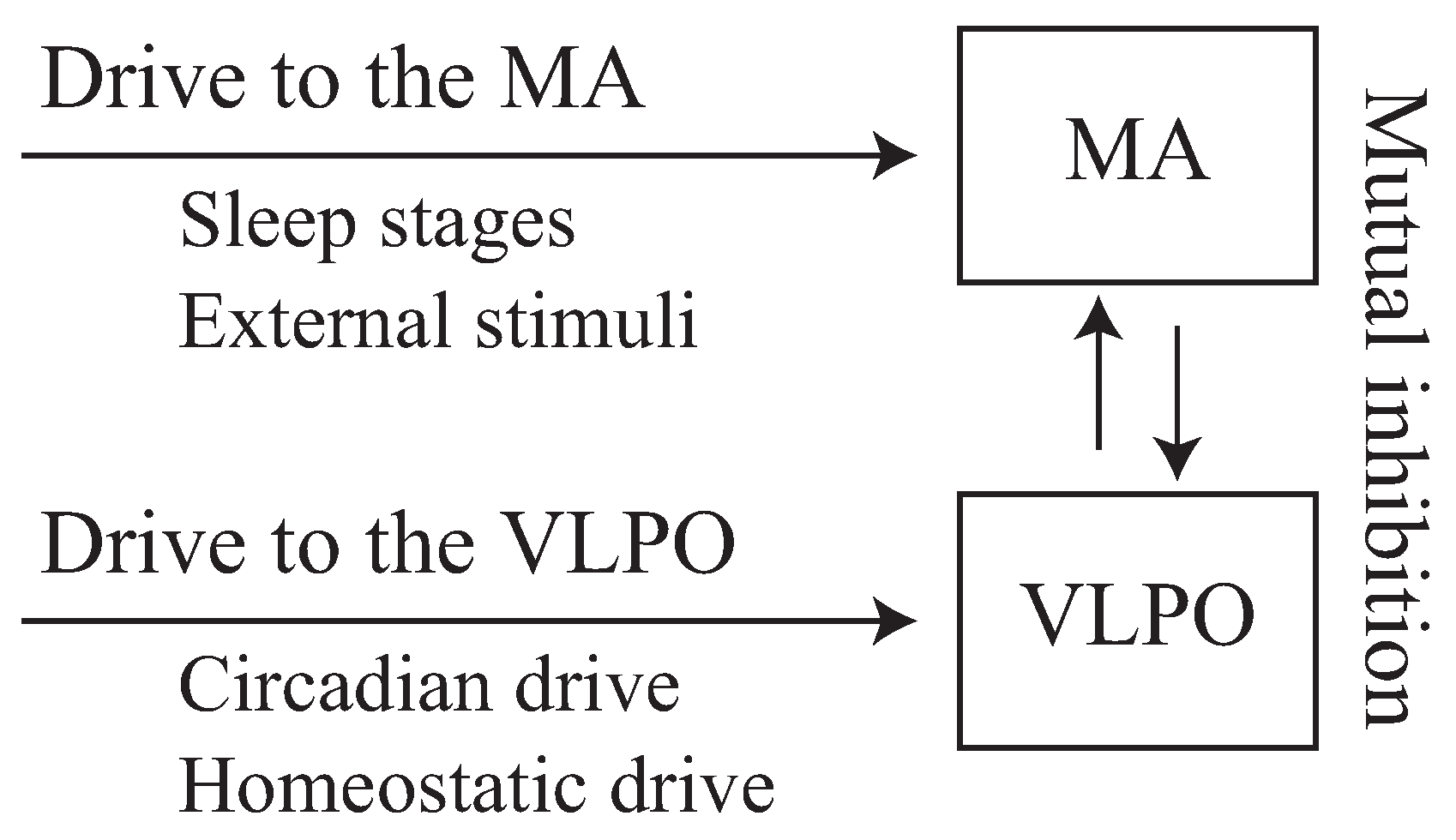
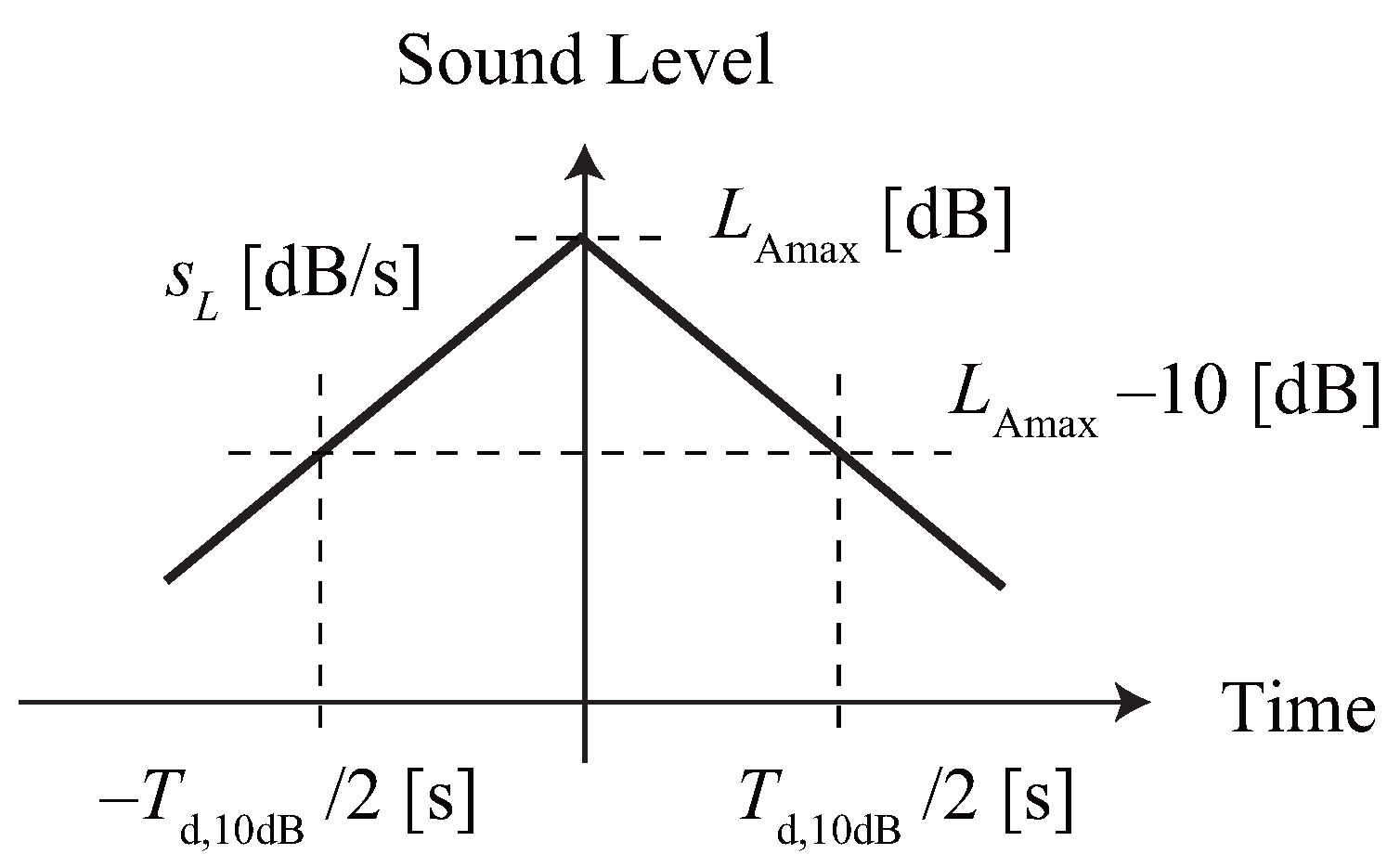
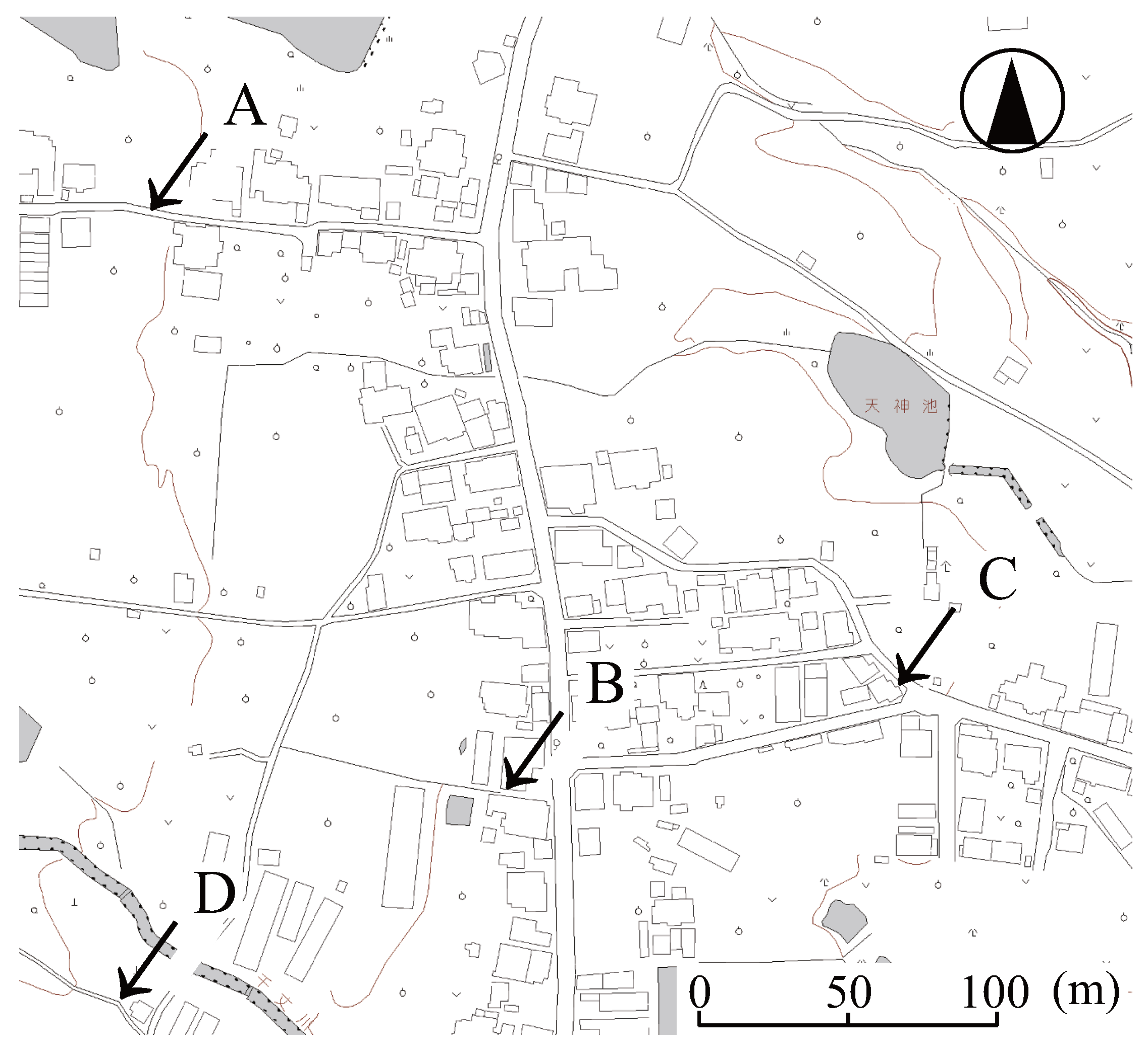
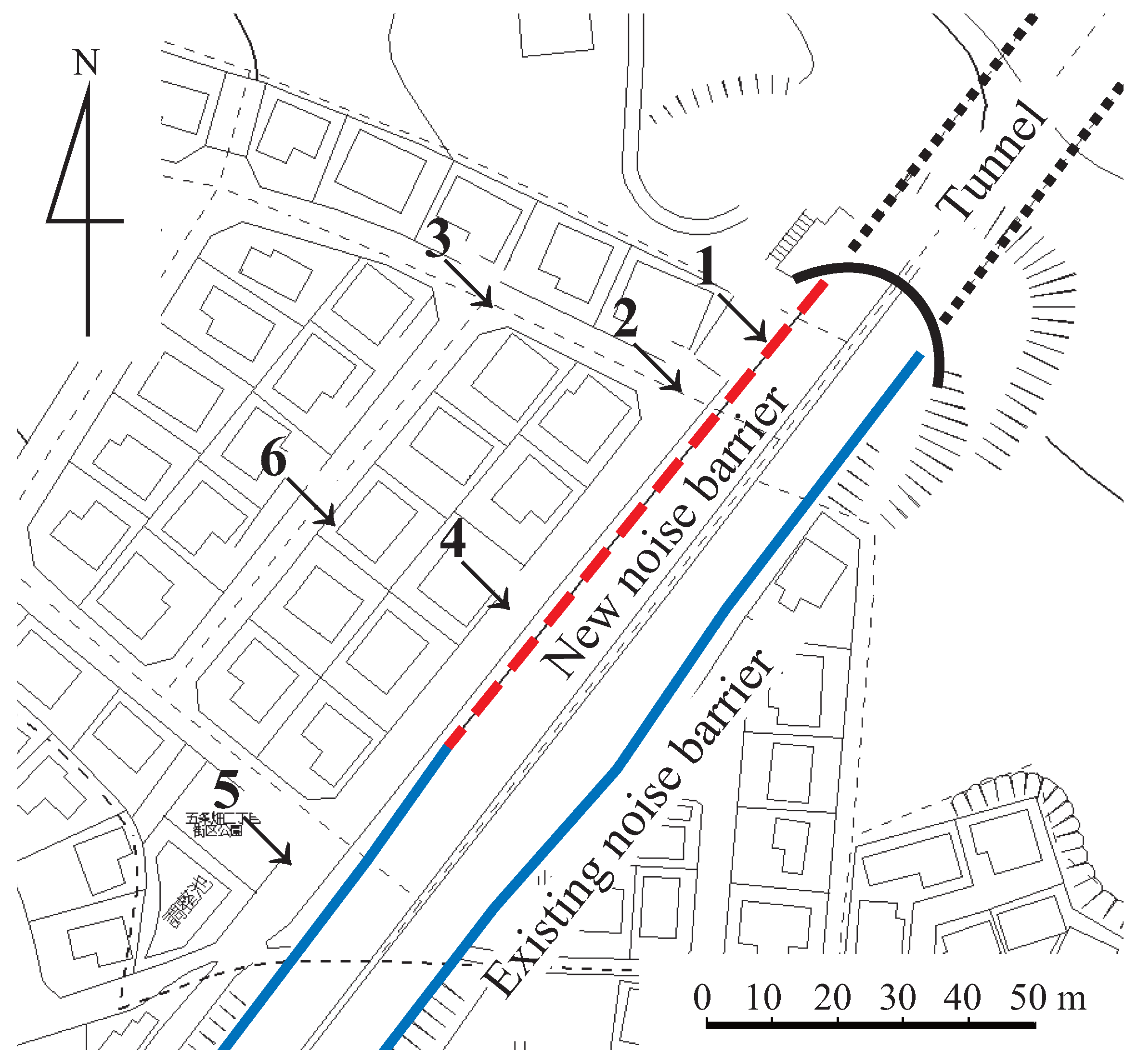
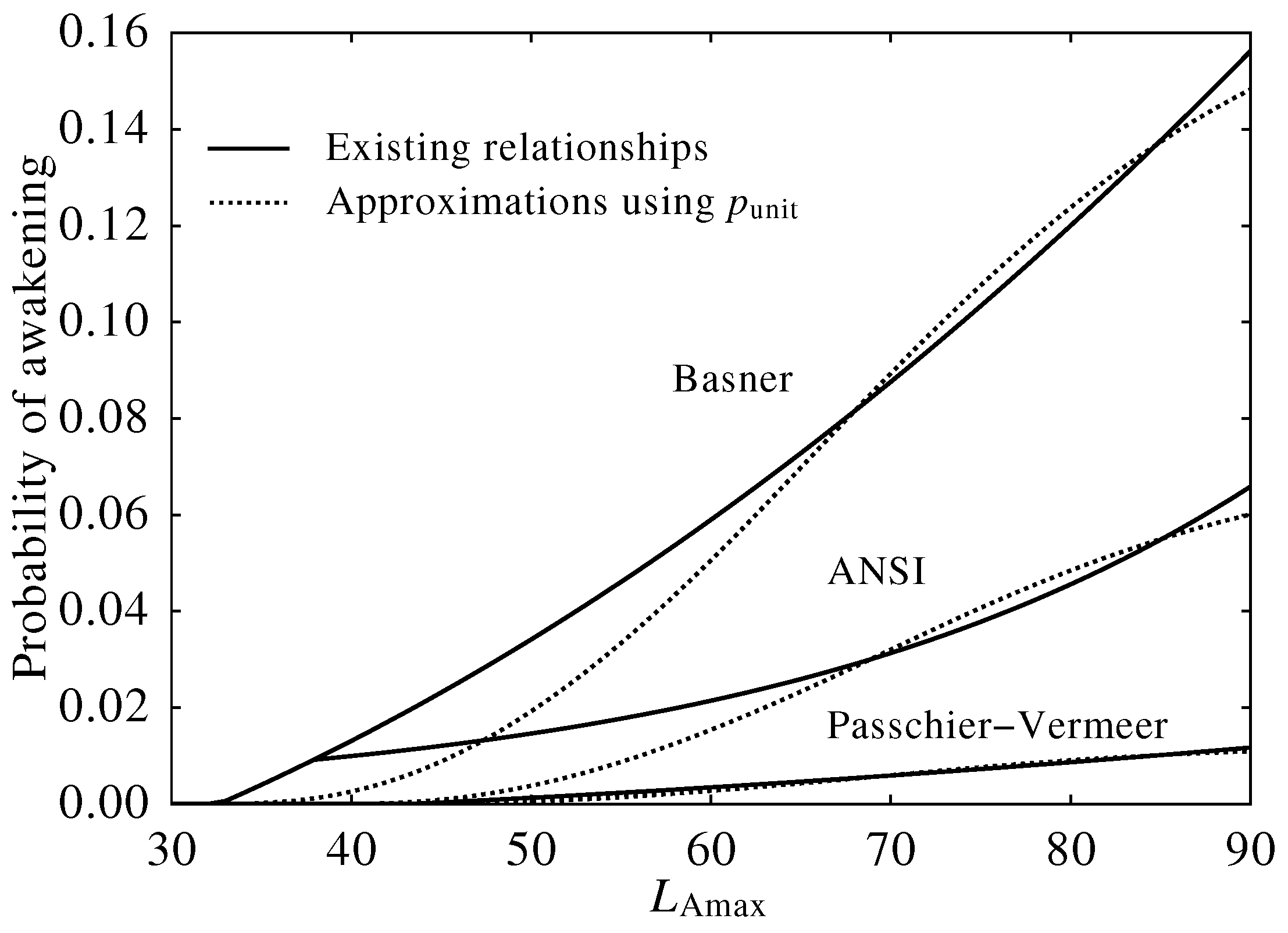



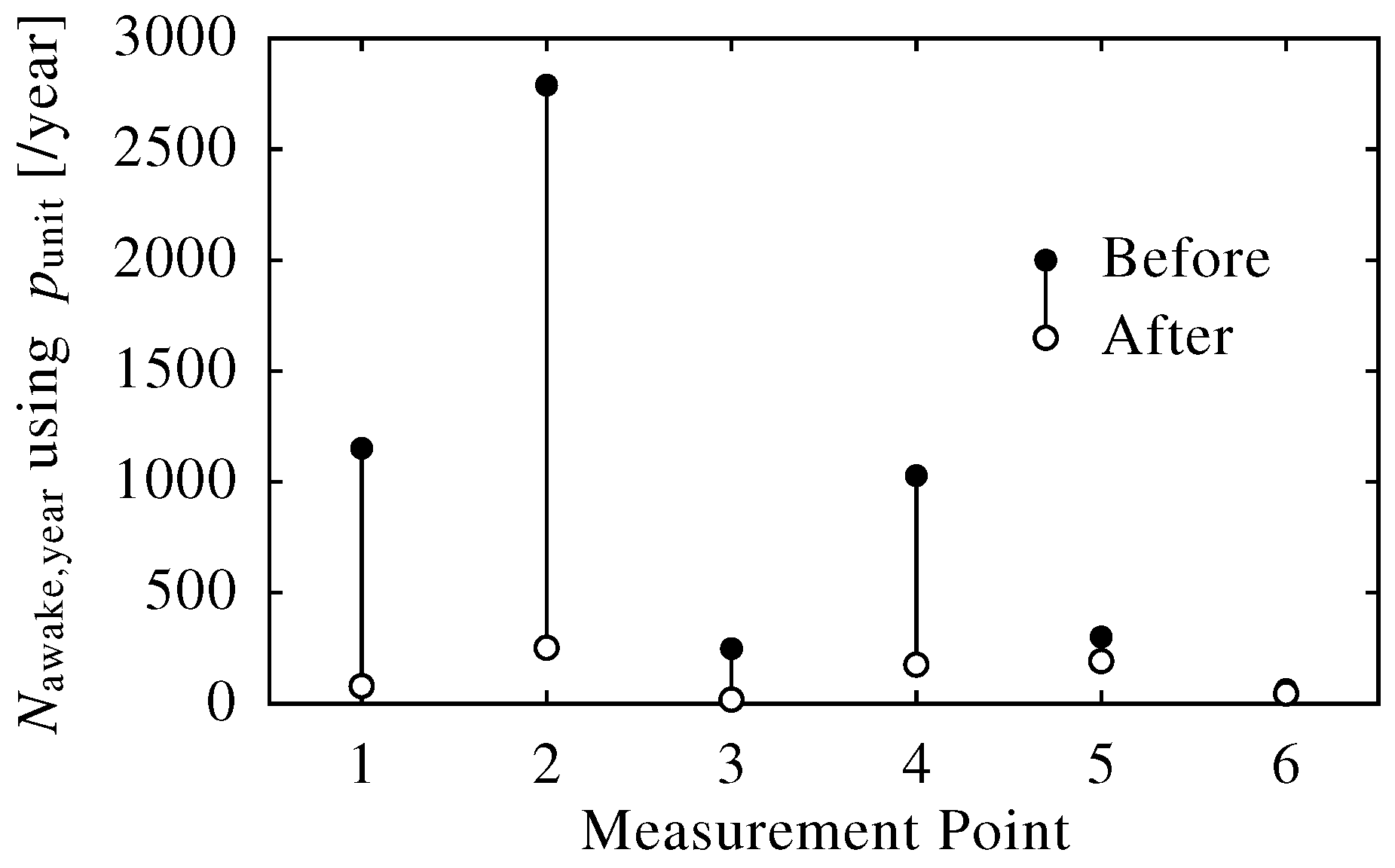
| Measured Point | |||||
|---|---|---|---|---|---|
| Index | A | B | C | D | |
| (dB) | 49.8 | 55.7 | 51.7 | 46.0 | |
| (dB) | 86.6 | 84.1 | 80.0 | 70.7 | |
| (year) | using the Passchier-Vermeer equation | 3.7 | 35.3 | 3.9 | 0.2 |
| using the ANSI equation | 21.4 | 205.7 | 49.1 | 1.2 | |
| using the Basner equation | 76.8 | 733.6 | 829.1 | 44.0 | |
© 2016 by the authors; licensee MDPI, Basel, Switzerland. This article is an open access article distributed under the terms and conditions of the Creative Commons by Attribution (CC-BY) license (http://creativecommons.org/licenses/by/4.0/).
Share and Cite
Tagusari, J.; Takashima, T.; Furukawa, S.; Matsui, T. Night-Time Noise Index Based on the Integration of Awakening Potential. Int. J. Environ. Res. Public Health 2016, 13, 272. https://doi.org/10.3390/ijerph13030272
Tagusari J, Takashima T, Furukawa S, Matsui T. Night-Time Noise Index Based on the Integration of Awakening Potential. International Journal of Environmental Research and Public Health. 2016; 13(3):272. https://doi.org/10.3390/ijerph13030272
Chicago/Turabian StyleTagusari, Junta, Tomoya Takashima, Satoshi Furukawa, and Toshihito Matsui. 2016. "Night-Time Noise Index Based on the Integration of Awakening Potential" International Journal of Environmental Research and Public Health 13, no. 3: 272. https://doi.org/10.3390/ijerph13030272






